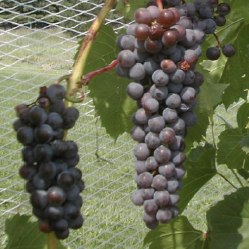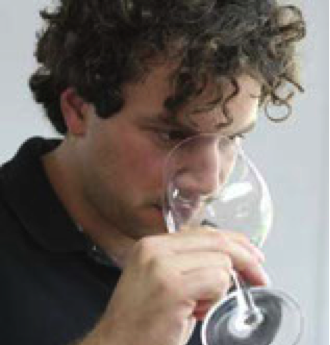The Effects of Cold Soak on Phenolic Extraction
Cold soak aims to enhance wine colour after extraction of anthocyanins — by leaving the juice soaking on skins for several days, the colour should become darker due to an increase in optical density.
To the consumer, wine colour is often indicative of overall quality. Anthocyanins are responsible for red wine colour and are present as polymeric complexes or as free anthocyanidins. Skin proanthocyanidins are considered to be softer and have a higher quality than the seed proanthocyanidins.
Anthocyanins are often released by aqueous extraction from the berry during a period of maceration. Maceration not only extracts anthocyanins, but other compounds including tannins, proteins and polysaccharides.
During fermentation, maceration is occurring simultaneously as the skin and juice are in contact and the anthocyanins are diffusing from the skins to the juice. The cell walls of the berry are broken down and the anthocyanins found in the cell vacuole are then extracted into the wine through a process of diffusion.
There are several different winemaking methods that aim to break down these cell walls and extract large amounts of phenolic pigments. A common method to induce phenolic extraction involves holding the un-inoculated must at cool temperatures of around 15°C, or at cold temperatures of around 4°C for an extended period of time prior to fermentation.
This process is what is known as a cold soak and is meant to improve wine colour after the slow aqueous extraction of the anthocyanins. The juice soaks with the skins for several days, after which the colour is theoretically darker due to an increase in optical density.
There are several aspects that impact the ability of the juice to extract colour during a cold soak including copigmentation, temperature and ethanol.
The molecular bonds that occur between the anthocyanins, pigments and other non-coloured organic components are the results of a process called copigmentation.
As much as 50% of the colour in red wines can be due to copigmentation, thus expressing a great impact on colour. This phenomenon is central to understanding how its behavior as a dynamic equilibrium is vitally important to the extent of colour extraction.
Copigmentation puts a limit on colour potential, the extraction of pigments, primarily anthocyanins, and the strength of the retention of these pigments for long term colour stability.
Because colour can change over time, the initial extraction of pigments is really only the first part of the long process of colour development. Literature points to the fact that an adsorption-desorption equilibrium exists between the pigment concentration at the cellular level in the grape skins and the pigments concentration in the wine.
Copigmentation will shift the anthocyanins and pigments out of the free anthocyanin pool of the adsorption equilibrium, which results in a greater potential for adsorption of pigments in the wine causing an elevated level of extraction.
Temperature plays one of the most vital roles in the entire winemaking process. The temperature of the alcoholic fermentation is extremely important, as studies have shown that there is a positive correlation between increasing temperatures and greater levels of colour extraction (Gao et al. 1997).
Therefore, it stands to reason that various temperatures of the cold soak will affect the wine, especially in conjunction with the temperature of the primary fermentation.
Reynolds et al (2001) found that Syrah increased levels of anthocyanins after a cold soak when it was coupled with lower fermentation temperatures, between 15 and 10 °C (P<0.05) but no increase was shown when the temperature of fermentation was around 30C.
Previous research on the subject of cold soak extraction suggests that the results of such a treatment are inconsistent or do not persist into the finished wine. Much of the literature directly contradicts the notion that the wine will extract more phenolics during a cold soak (Heatherbellet al. 1996 and Koyama et al. 2007).
The effects of ethanol and temperature on anthocyanins and tannins would be more likely to hinder the extraction rather than promote it.
Table 1. Spectrographic Data of Varying Cold Soak Treatment Temperatures
| Sample | A280 nm | A280-4 | A420 nm | A520 nm | Hue (A420/A520) | Colour Intensity (A420+A520) |
| Control | 39.73 | 35.73 | 1.02 | 1.67 | 0.611 | 2.69 |
| 2C | 38.21 | 34.21 | 1.08 | 1.59 | 0.679 | 2.67 |
| 6C | 43.31 | 39.31 | 1.40 | 2.02 | 0.693 | 3.42 |
| 10C | 37.98 | 33.98 | 1.45 | 2.09 | 0.694 | 3.54 |
Somers and Evans (1979) found a loss in anthocyanins and total phenolics in Syrah wines after a heat treatment. They attributed the loss to the effect that ethanol has on the structures of deeply coloured pigment aggregates present in the juice prior to fermentation, which suggests that this same phenomenon may occur after a cold soak as well. As ethanol increases, there is a significant reduction in the equilibrium of the pigment concentration in the wine and the concentration in the grape skins, and as mentioned before, higher temperatures are correlated with pigment extraction as opposed to cold temperatures (Gao et al. 1997).
However, this portion of literature tends to look at wine post-bottling. The polymerisation of pigments that commences during this period tends to reduce the differences seen in anthocyanin concentrations of cold soaked and control wines (Sacchi et al. 2005).
Other than varietal factors, climatic factors and the condition of fruit maturity will also greatly influence the anthocyanin content of the berries. Other factors limiting the intensity of extraction are the concentrations of certain cofactors present in the skins at harvest and their solubility under the conditions that the juice or wine creates.
The ultimate limitation to extraction is the amount of coloured pigments present in the berry. This radically changes from variety to variety, and some varieties, such as Pinot noir, are notorious for low concentrations of anthocyanins that results in poor colour development.
Syrah has proven difficult to display a colour difference in scientific experiments. One study analysed Cabernet Sauvignon, Monastrell and Syrah after a 10-day, 10°C cold soak.
Both the Cabernet Sauvignon and the Monastrell showed positive differences in colour extraction while Syrah showed no effect (Busse- Valverde et al. 2010). Gil-Muñoz et al. (2001) also found no significant increase in anthocyanin extraction from Syrah which had undergone pre-fermentative cold soak (P>0.05).
Materials and methods Syrah grapes were harvested from the UC Davis vineyards in September of 2011. The fruit was then crushed and de-stemmed using a Delta E1 (BucherVaslin).
The processed fruit was then allocated to four 55 gallon research fermenters. These vessels are made of stainless steel, jacketed for temperature control and are designed for variable capacity.
Each must was then dosed with 50ppm of SO2. Three of the musts were then stored at 2oC, 6oC and 10C during a period of cold soak for two weeks prior to inoculation. The control was immediately inoculated with Lalvin EC 1118 (Saccharomyces cerevisiae bayanus).
The cold soaked tanks were also inoculated in the same fashion. The maximum fermentative temperature was 27C and the tanks were completely pumped over twice daily.
Upon the completion of fermentation, each tank was then pressed using a specially designed hydraulic press. The wine was then inoculated with Viniflora Oenos (Oenococcus oeni).
Upon completion of MLF, 50ppm SO2 was added to attain a free sulfur dioxide content of about 30ppm and racked from its lees into stainless steel barrels with limited headspace.
The wine was then kept in a cool room and topped with N2 gas biweekly. The finished wines were bottled in the UC Davis winery.
After bottling, the wines were analysed for colour and phenolic concentration using a Hewlett Packard 8453 UV-Vis Spectrometer.
The wines were also analysed in a duo-trio test in which a panel of eight participants was asked to evaluate the colour of a reference wine and then choose the same wine from two other wines.
Results
Spectrophotometric readings were taken on all the finished wines in order to estimate phenolic content and colour and the results of which are summarised in Table 1.
Table 2. Duo-trio sensory analysis of treatments, analyzed for colour. Temperatures incubated for cold soak indicated as well as the sample used for the reference (R).
| Comparison | % correct | Significant (P<0.05) |
| Control (R) vs 2C | 33% | No |
| 10C (R) vs @C | 87.5% | Yes |
| Control (R) vs 6C | 75% | No |
| 10C (R) vs 6C | 87.5% | Yes |
| Control (R) vs 10C | 37.5% | No |
| 2C (R) vs 6C | 75% | No |
Discussion
The cold soak at 6C and 10C, but not 2C, resulted in an increase in anthocyanin extraction as evident by the increase in colour intensity measurement (Table 1).
This suggested that the increased extraction was most likely the extraction of anthocyanin monomers such as malvadin 3-glucoside since the monomeric anthocyanins have been implicated in colour intensity (Gao et al. 1997).
Since monomeric anthocyanins typically polymerise during aging, leading to increased colour stability (A420) but decreased intensity (A520), the results of the spectrophotometric data also suggest that the polymeric anthocyanins may have increased as evident by the increase in hue since polymeric anthocyanins absorb at 420nm.
These results contradicted results in the literature. Gardner et al. (2010) found that a cold soak treatment of Cabernet Sauvignon musts increased the polymeric anothcyanins, but had no effect on the monomeric anthocyanins as a function of colour intensity.
It is possible that the extraction of anthocyanins is dependent upon variety and can be influenced by small differences in the vinification process. The spectrophotometric data did not match the data obtained from the sensory trial. The only treatments that participants were able to correctly match to the reference with any statistical significance was the 10C treatment compared to the 6C as well as the 10C treatment compared to the 2C treatment (Table 2).
The expectation is that if there was a true difference between the higher temperature cold soak treatments and this difference was interpreted by the panel as either colour intensity or hue, then the most dissimilar wines would be the 10C cold soak and the control, as there was the greatest difference inboth categories (Table 2).
There was no significant difference between the colours of these two wines, when analysed by the sensory panel, however. One would also expect that the wine produced by the 6C cold soak would also be too similar to the wine produced by the 10C to be differentiated when the spectrophotometric data are used exclusively, but this difference was detected by the sensory analysis.
Since the wines were not filtered, it is possible that there was a difference in turbidity from the residual yeast lees carried over during racking, that may have been perceived by the panellists.
Since the cold soak treatment is supposed to increase overall phenolic extraction, the A280 nm was measured in an attempt to quantify the total phenolics (Table 1). The A280 nm was measured and four absorbance units subtracted from it to account for the flavonoids naturally present as non-desirable phenolics. The A280 -4 measurement is a gross approximation for estimated total phenolic content by subtracting out what a study by Somers and Ziemelis (1985) found to be the average value for flavonoid concentration in commercial wines. It is likely that these wines had low flavonoid content, which resulted in the low total A280, and not that there is a complete absence ofanthocyanins and other phenolics.
The utility of this estimation is that it is a good comparison to use between wines producedin a similar manner from the same lot of must. It is surprising however that in this case the 10C cold soak treatment wine did not have the highest phenolic content as determined by themethods employed in this study, even though the wine had the highest colour intensity. It is possible that they simply were not extracted but this is anomalous, as temperatures for cold soak and fermentation were high and temperature has been shown to be the most important variable for phenolic extraction (Gao et al. 1997).
The value of the A280 was low for a commercial wine as the study by Somers and Ziemelis (1985) analysed 400 commercial red wines from Australia and found that the range in A280 -4 values was between 23 and 100 with an average of 50. The wines produced here were substantially lower most likely the result of immature fruit.
Wines with values greater than 40 may benefit from aging, suggesting the wines produced here would likely need to be consumed early.
The current study demonstrated some consistencies as well as discrepancies with the previous research but the literature on cold soak itself is quite contradictory. A study by Busse-Valverde et al. (2010) found that a cold soak treatment was ineffective in extracting anthocyanins from Syrah seeds and skins but was effective with Cabernet Sauvignon and Monastrell varieties. Gardner et al. (2010) found that a cold soak treatment for Cabernet Sauvignon was ineffective in extracting higher amounts of phenolics, but was successful in producing a wine with a higher hue but with no significant change in intensity.
The results of our trial coupled with the results from the previous research suggest that a cold soak treatment may be effective in increasing total anthocyanin levels in young wines, but this phenomenon is most likely dependent on a number of variables including temperature and duration of cold soak, grape variety, vinification process and aging regimen.
Russell Moss the Director of Research and Development at Viticultura Consulting LTD. in Central Otago, New Zealand (www.viticultura.co.nz). Russell’s mother grew up in Traverse City, Michigan, where his grandmother, aunts and uncles still reside. He spent his formative years at Interlochen Arts Camp and went to High School at Interlochen Arts Academy, where he played bass trombone. Russell has many fond memories of enjoying local Traverse City wines with his friends and family along the shore of Lake Michigan and the spectacularly beautiful Grand Traverse Bay.
This article first appeared in the May 2013 issue of Australia and New Zealand Grape Grower and Winemaker Magazine. and is reprinted with permission of the publication.
Authors:
Russell Moss: jamesrussell.moss@lincolnuni.ac.nz
Kelsey Daniels: kdaniels7@msn.com
Jeff Shasky: jeffsky7@gmail.com
For references please click this link.





A well researched paper from an up and coming wine scientist!